Although fleet growth has slowed somewhat, newbuilds are still coming online, and older rigs continue to be reactivated to meet increased demand. Meanwhile, rig utilization dipped as additions outpaced activity.
Steve Berkman and Tory Stokes, ReedHycalog, Houston
The drilling industry has experienced sustained growth during the past few years due to strong market conditions and a continued fleet expansion program. A favorable environment has allowed additional companies to enter the business and new rigs to be built. According to the 55th annual ReedHycalog Rig Census, fleet growth has slowed somewhat over the last year, but newly manufactured units are still coming online, and older rigs continue to be reactivated to meet increased demand.
To assemble a complete picture of the global rig market, ReedHycalog works closely with RigData and ODS-Petrodata to summarize the US and global offshore mobile rig fleets. ReedHycalog personnel in Calgary gather the Canadian numbers. Estimates for the overall international land rig fleet are compiled by ReedHycalog regional managers and submitted for this report.
CENSUS STATISTICAL HIGHLIGHTS
Key statistics from the 2008 census include the following:
- The US rig fleet had a net gain of 259 rigs this year, boosting the total fleet by another 9% to 3,076 rigs. This net increase is the result of 347 rig additions and 88 rig deletions during the past year, Fig. 1
- Newly manufactured rigs, at 202 units, were the largest addition to the US fleet in 2008, as in 2007
- The total number of US rigs meeting the census definition of “active” was 2,541, vs. 2,402 last year, an increase of 6%
- US rig utilization fell slightly to 83% from 85% in 2007, Fig. 2
- The total number of US rig owners grew by 11 companies this year to 321
- Drilling contractors own 88% of all drilling rigs, with operators owning the remaining 12%
- The Canadian available rig fleet continues to set record highs, now at 875 units, a net increase of four rigs. This includes 47 newly manufactured rigs added to the fleet this year
- Canadian rig activity rose 9% this year, causing utilization to increase to 46% from 43%
- The global offshore mobile fleet expanded by a net gain of 25 available rigs, or 4%, due primarily to newbuilds
- Global offshore mobile activity was up about 3%, with utilization remaining at 88%
- Outside the US and Canada, utilization dropped about two percentage points to 92% from 94% in 2007.
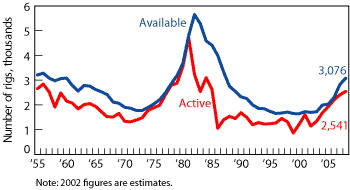 |
|
Fig. 1. US available vs. active rigs, 1955-2008.
|
|
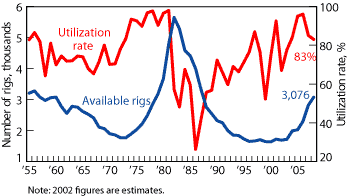 |
|
Fig. 2. US available rigs vs. utilization, 1955-2008.
|
|
RIG AVAILABILITY: MORE NEWBUILDS ENTER U.S. FLEET
Rapid fleet expansion due primarily to newly manufactured units is noteworthy again in 2008 as rig-building programs initiated a few years ago continue to come to fruition. Drilling companies also continue reactivating and refurbishing older units that are still viable. With the assistance of RigData, census takers reported that the US fleet added 347 rigs over the past year, down from 614 units gained in 2007. The 347 rigs added to the fleet more than offset reductions. Fleet additions fall into one of four categories, Table 1:
- Newly manufactured rigs
- Rigs brought back into service
- Rigs assembled from parts
- Rigs moved into the country.
TABLE 1. Changes in the available US fleet
Click table to enlarge |
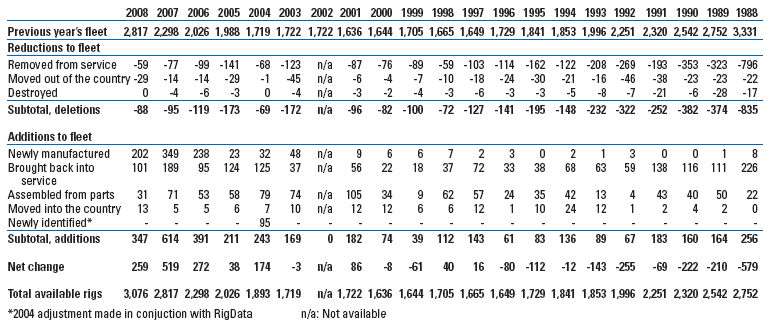 |
|
For the past three years, newbuilds have been the top reason for rig fleet growth. Most of this year’s gain again comes from 202 rigs that were newly constructed. This was a reduction from the 349 rigs with this classification last year, but still a sizeable number. This brings the total number of newbuilds added over the past three years to 789, about a quarter of the total US fleet. All 202 new rigs added this year were reported to be land rigs.
The number of US rigs brought back into service also declined for 2008, 101 units vs. 189 that were reactivated in the 2007 census. Each of these rigs had been accounted for previously, but had been later removed from the census count due to becoming inactive or inoperable. As market conditions improved, these rigs were reactivated or refurbished and put back into service.
This year’s census counted 31 rigs assembled from component parts that were brought into the fleet for the first time. This compares to 71 units last year. An increasing percentage of rigs added to the fleet are newbuilds instead of assembled from components, although some owners still find it more economical to create rigs from at least some reconditioned parts.
Rigs brought into the US from other countries are also noted in the census. Thirteen rigs were imported over the past year, vs. five in the 2007 count. More than half of the rigs entering the US this year came from Canada. Rig movement out of the US is covered below.
U.S. RIG ATTRITION STABILIZES
Some rigs will always need to be removed from service when the machinery becomes obsolete and is no longer cost-effective to operate. Other rigs move out of the US to other lucrative markets. All of these rigs are tabulated in the annual census, with this year’s deletions totaling 88 units, just seven fewer than last year. Deletions to the fleet were reported in three categories, Table 1:
- Rigs removed from service
- Rigs moved out of the country
- Destroyed rigs.
Rigs removed from service continue to comprise the largest category of deletions, declining to 59 units this year, vs. 77 in 2007. The number of rigs removed from service has been diminishing for the past three years, mostly due to the strong new fleet that has been built. Census rules exclude rigs from the available count that have been stacked for a significant amount of time, require a large capital expenditure to be operable, or have been auctioned for parts or cannibalized to keep other rigs running.
As mentioned previously, rigs that move into or out of the country are tracked in the census each year. In 2008, 29 rigs were reported as moving out of the US, more than double the 14 that left last year. More than half of these rigs were headed to Central and South America. Considering that 29 rigs moved out of the country for the 2008 census while 13 moved in, there was a net decline of 16 units resulting from rig moves, marking a four-year trend of more rigs leaving the US than entering.
Rigs that were destroyed comprise the last category of deletions. Fortunately, this year there were no reported mishaps that were serious enough to cause irreparable damage to rigs.
Total rig additions numbered 614, while deletions totaled 95. The net change in the fleet over the past year was a 519-unit increase, showing a considerable swell in rig availability, Fig. 3.
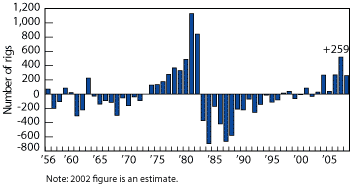 |
|
Fig. 3. US change in available rigs, 1956-2008.
|
|
CANADIAN FLEET ATTAINS ANOTHER RECORD HIGH
The Canadian market remains strong and has added even more rigs to its expanding fleet. Rig building boosted Canada’s numbers by 47 units this year. This is down from the 86 newly manufactured rigs in 2007, but still a considerable number of additions. Except for one unit that was brought back into service, every rig entering the fleet this year was a newbuild. No rigs were reported as assembled from parts or as having moved into the country.
Cutbacks to the Canadian fleet this year numbered 44 units. Twenty-four units were retired or used for parts this year, significantly more than the six in 2007. More rigs also left Canada in 2008, 19 compared with 10 the previous year. One unit was reported as destroyed during the year. Subtracting these 44 units from the 48 additions leaves a net increase of just four rigs and a total available count of 875. Although this is less than a 1% increase, it still sets another record for Canada’s available count, Table 2.
| TABLE 2. Changes to the Canadian rig fleet |
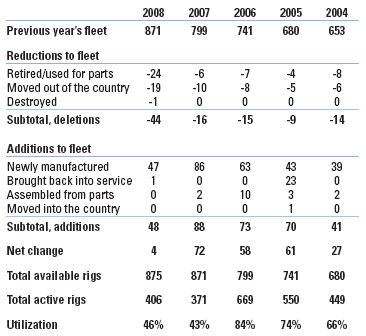 |
|
GLOBAL OFFSHORE MOBILE FLEET EXPANDS
In a similar vein, the global offshore mobile rig fleet experienced growth this year chiefly due to rig building. All rigs that entered the fleet this year were either newly manufactured or brought back into service. Twenty-eight brand new units were added this year, compared with 11 in 2007. ODS-Petrodata calculates that 59 units are scheduled for delivery by the time the next census rolls around, although some will certainly not meet that timetable.
Rigs that have been down for a number of years are sometimes brought out of retirement due to improved drilling conditions. Reactivated rigs numbered four, a decline from the 11 that were brought back into service in the previous census. No new rigs entering the fleet this year were described as assembled from parts.
Reductions to the global offshore mobile fleet numbered just seven for this census, a decline of 19 units from the 26 rigs retired in 2007. Most of these out-of-service rigs are considered “cold-stacked” and have not worked for more than five years. Occasionally these rigs will be put back into service, but generally it would take a significant capital expenditure to do so. Therefore these drilling units cannot be counted as “available” by census rules. Due to a mild hurricane season as well as good fortune, no global offshore rigs were removed from service due to being destroyed during the past year, Table 3.
| TABLE 3. Changes to the global offshore mobile fleet |
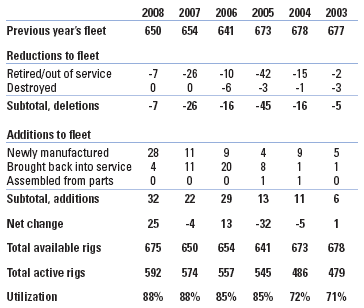 |
|
Overall, the net increase in global offshore mobile units was 25 rigs, bringing the available count up by 4% to 675. The worldwide offshore fleet is widely distributed, with the US still dominating, followed by the Persian Gulf and then Southeast Asia, Fig. 4. The makeup of the fleet by rig type is shown in Fig. 5, but does not include platform and inland barges in the distribution.
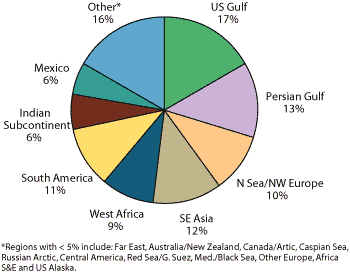 |
|
Fig. 3. Mobile offshore fleet by region, 2008.
|
|
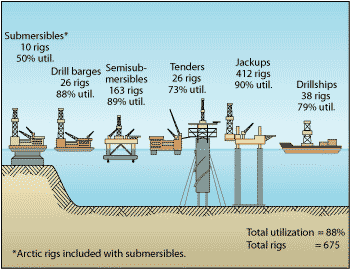 |
|
Fig. 5. Makeup of the global offshore mobile fleet, 2008.
|
|
U.S. ACTIVITY RISES WHILE UTILIZATION DECLINES SLIGHTLY
The methodology used to count active rigs for the ReedHycalog census is different from other active rig counts that are reported weekly. This census counts a rig as active if it has “turned to the right” at any time during a defined 45-day period-between May 7 and June 20 for 2008. Therefore, the ReedHycalog statistic will always be higher than other reported weekly rig counts, because a longer time period is used to monitor activity.
The 2008 active rig count was up again this year, reflecting current improved market conditions. The active rig count climbed another 6% to 2,541 this year after climbing 9% in 2007. Last year’s rigs identified as working during the census period numbered 2,402.
Rig utilization, the supply and demand balance of rigs, is an often-quoted industry statistic. Despite the strong market, utilization dipped slightly this year since activity didn’t match the rate of all the new available rigs brought online. Utilization had been in the 90% range for a few years, but then dropped to 85% last year. This year’s ratio dipped a little further to 83%.
The 535 available rigs that were not working during the census period were classified according to the length of time they had been idle. Some units not actively drilling are currently under contract and awaiting the start of their project, or being moved to their next drilling location. Rigs stacked less than one year numbered 375; one to two years, 160; and two to three years, 0. Aging rules of the census state that any rig stacked for longer than three years will be removed from the available fleet, although most rigs tend to be decommissioned before their stacked classification targets them for deletion. Rigs removed from the fleet for this reason fall into the category “removed from service.”
Another figure often quoted in the census is full-year utilization, which is the total percentage of available rigs that drilled sometime during the past year. Adding the 375 rigs stacked less than one year to the 2,541 active units in the census provides this number. This full-year utilization figure indicates that rig owners put 2,916 units, or 94.8% of available rigs, to work over the past year. Although the total number of rigs that worked increased this year, the full-year utilization rate fell from 99.5% last year.
Examining 2008 census figures for the US by region shows most regions with increases in rig activity. This regional breakdown, comparing statistics for this year and last, is shown in Table 4. Again, the ArkLaTex region showed the highest overall number of active rigs at 493, with a 38-unit increase. The Mid-Continent area outpaced the ArkLaTex increase by one rig with 39 additions to total 417 units this year.
TABLE 4. US regional census results
Click table to enlarge |
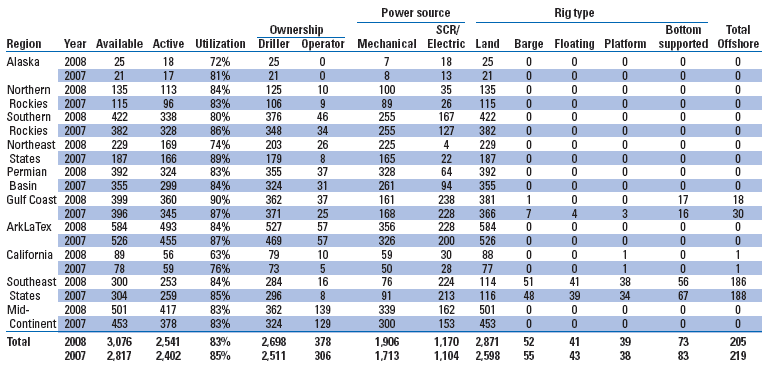 |
|
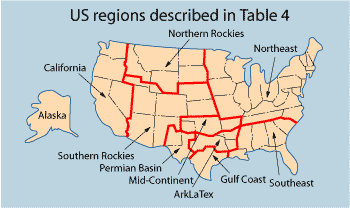
Utilization by region shows mixed results, with seven regions registering declines, two regionsshowing increases, and one remaining steady. Figures for each region are as follows:
- Alaska, 72%
- Northern Rockies, 84%
- Southern Rockies, 80%
- Northeast states, 74%
- Permian Basin, 83%
- Gulf Coast, 90%
- ArkLaTex, 84%
- California, 63%
- Southeast states, 84%
- Mid-Continent, 83%.
For some specific markets or rig types, demand may exceed supply. However, these levels indicate that every region does have some excess rig capacity.
Examining US land rigs, gross rig utilization was down four percentage points this year to 82% from 86% in 2007, Table 5, Fig. 6. The reverse occurred for the US marine fleet, where offshore utilization climbed to 86% from 82% last year. Floating rigs remain in greatest demand, with 90% utilization at census time. Rigs showing the lowest utilization are the offshore platforms, at 72%. Rig availability broken down by depth capacity reveals that units in most depth ranges experienced utilization downturns. However, those capable of drilling from 16,000 to 19,999 ft and those drilling from 13,000 to 15,999 ft each rose one percentage point, Table 6.
| TABLE 5. US land rigs, number and utilization |
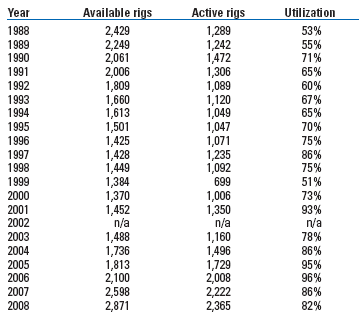 |
|
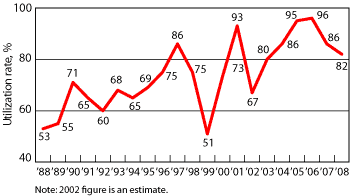 |
|
Fig. 6. US land rig utilization, 1988-2008.
|
|
| TABLE 6. US rig utilization by depth capacity |
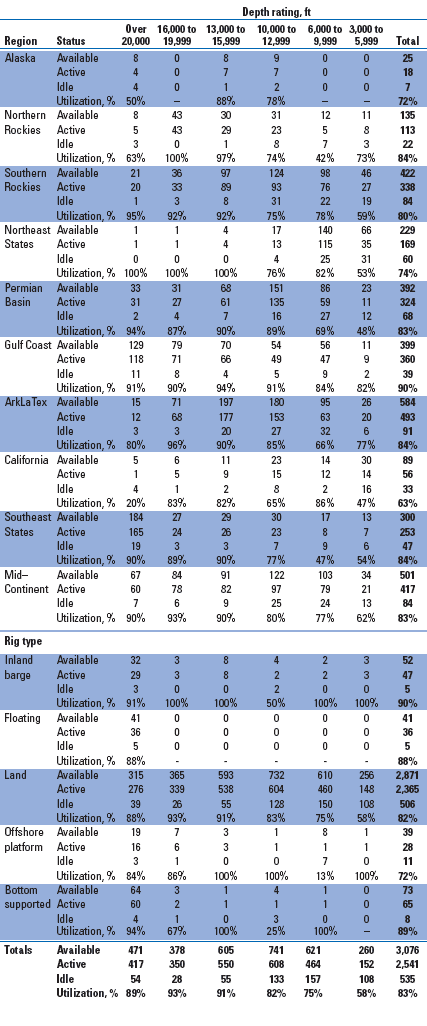 |
|
CANADIAN ACTIVITY TURNS AROUND
Canada may have begun a gradual rebound in activity after a significant decline of 45% in 2007. Last year’s considerable plummet was attributed to the drop in natural gas prices and the resulting reduction in gas drilling. This year’s activity level measured a rig count of 406 units during the spring census period of May 7 to June 20, a rise of 9%. Canadian utilization is beginning to recover, inching up to 46% from 43% last year. Last year’s dive was a huge decline from a solid 84% in 2006, Fig. 7.
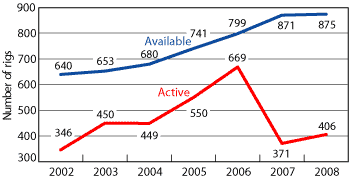 |
|
Fig. 7. Canada available vs. active rigs, 2002-2008.
|
|
The bulk of the Canadian active and available fleet resides in the 6,000-9,999-ft range. Fleet availability and activity by depth capacity show that utilization is now highest in the 16,000-19,999-ft range (57%) and again lowest in the 10,000-12,999-ft range (32%), Fig. 8.
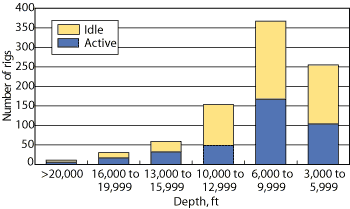 |
|
Fig. 8. Canadian rigs by depth capacity, 2008.
|
|
INTERNATIONAL LAND RIG UTILIZATION SLIPS SLIGHTLY
ReedHycalog has tracked international land rig activity for the past several years and continues to improve on the reliability of these figures. Utilization rates, comparing the past three years, are shown in Table 7 for the primary international regions. Overall, utilization was down a couple of percentage points to 92% from 94% a year ago.
| TABLE 7. International utilization |
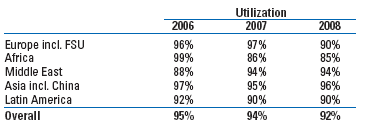 |
|
Changes in rig counts for Russia and China have been incorporated over the past two years as better intelligence has become available for these countries. This year, it is also the case for India. Adding these active rigs, the combined total of working international land rigs has risen to 3,965 from 3,724, an increase of about 6%.
International land rig availability has experienced a 9% increase this year to 4,297 rigs. In part, this is due to improved numbers becoming obtainable in several areas in Eastern Europe. Despite the jump in international availability, utilization declined somewhat since activity didn’t match the pace. However, most areas continue to be relatively tight, still exceeding 90% utilization. Africa is the only exception, remaining relatively low due to inactivity in the Nigerian barge fleet caused by current unrest and security threats.
As mentioned in previous years, it has been observed that some international areas have large numbers of available rigs, but these units are typically of older technology and may not be universally mobile or marketable. Also, in some cases, available rigs are actually under contract awaiting a project start, and are realistically unavailable for other work.
GLOBAL OFFSHORE MOBILE FLEET UTILIZATION UNCHANGED
The global offshore mobile fleet (which excludes platform and inland barge rigs in this census) experienced another 3% rise in activity during the 2008 census period. Total working rigs numbered 592 during the spring 45-day active period, up from 574 in 2007. With both available rigs and active rigs showing similar increases, overall utilization was stable at 88%, Fig. 9.
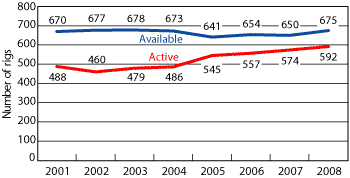 |
|
Fig. 9. Global offshore mobile available vs. active rigs, 2001-2008.
|
|
OTHER U.S. INDUSTRY TRENDS
One interesting side note related to the uptick in drilling activity is that newly established companies have been entering the market in recent years. This is particularly encouraging after many years of declines and a low of 179 rig owners just six years ago. Today the industry is back up to 321 owners with 11 companies added over the past year, Fig. 10.
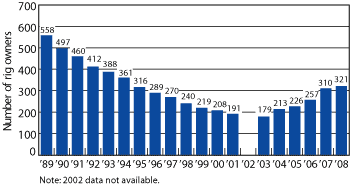 |
|
Fig. 10. US rig owners, 1987-2008.
|
|
The census tracks the ownership of rigs by drilling contractors vs. operators, with considerably more rigs always being owned by drilling contractors. This remains the case in 2008, but the number of operator-owned rigs has risen in recent years. This year’s census counted 43 operators, compared with 38 in 2007. Operators now own about 12% of the overall US fleet, up from 11% in 2007 and 5% in 2006.
Generally, the trend of mergers and acquisitions causes some of the larger companies to grow by increasing their rig holdings. However, many small owners also find it profitable to operate in select markets. Thus, many of the new companies counted this year have a single rig. Census statistics have been examining US rig ownership for more than a decade and now show that companies with more than 20 rigs in their fleets own 60% of all drilling rigs, down one percentage point from last year, Fig. 11.
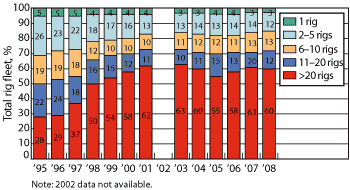 |
|
Fig. 11. US rig ownership by fleet size, 1993-2008.
|
|
CONTRACTORS CONCERNED ABOUT RIG RATES
As part of the annual census, drilling contractors are surveyed regarding their opinions of the industry. Although respondents are not necessarily the same each year, every year’s input is revealing as it highlights interesting viewpoints and concerns. Contractors are asked to rank some key issues of importance and estimate a number of changes to their business, both past and anticipated.
Forty-five drilling contractors participated in this year’s survey, about 14% of all US rig owners, and representing 27% of the total US fleet and 3% of the total Canadian fleet. These companies were a wide mix both in size and in regions represented.
For the past 18 years, respondents have been asked to rank a set of issues by importance to their business. “Rig rates” and “crew availability” are often the top two concerns to contractors, and this year was no different. In a reversal of last year, “crew availability” was the No. 1 concern this year, followed by “rig rates.” With rig activity continuing to climb, contractors find it increasingly difficult to locate and retain good rig hands. Moreover, hourly crew labor rates have increased an average of 6% over the past year. This is a cost that escalates annually and greatly impacts the bottom line if rig rates do not keep up.
Again in third place for highest concern is “availability of rig parts.” The supply of older rigs that can be cannibalized to keep other rigs running has been on the decline. With rig demand high, equipment shortages can be troublesome and expensive.
Maintenance expenses also continue to mount for contractors, although they are reported to be rising at a slower rate than in previous years, possibility due to a larger portion of the fleet being newbuilds. On average, maintenance costs climbed another 5% this year.
Contractors responding to the survey indicated that their rig activity has been up on average 7% since this time last year. This is consistent with the increased level of activity shown in the census results for 2008. Furthermore, these companies are optimistic and expect activity to remain brisk and to actually rise another 10% over the coming year. According to survey data, land rig rates in actual dollars have averaged $14,740/day during the May-June period of this year.
When asked what level oil and gas prices needed to drop below to have a negative effect on their business, contractors estimated on average $69.40/bbl for oil and $6.30/Mcf for gas.
RIG BUILDING CONTINUES
Most contractor survey respondents feel confident that the industry will remain strong over the next several years. When asked to describe their companies’ plans for the next five years, a large percentage of owners, 49%, said they expect to expand their fleets, while 42% have no plans for change. Anticipated additions during the next 12 months for just the 45 respondents include 35 refurbished rigs and 52 newly manufactured units for the US and Canada. Other industry sources indicate that total US-based contractors are expecting at least 180 more new rigs to enter the fleet over the next few years.
US UTILIZATION HOLDS STEADY
New rig rollouts will continue, and ReedHycalog predicts that only slightly fewer rigs will be added to the fleet over the next year. Overall, it is anticipated that the US available count will climb further for the 2009 census, possibly by another 250-plus rigs. Even with a weaker US economy, worldwide demand for oil will keep commodity prices high and rig activity rising. Based on this forecast, the utilization rate for the US would inch up another percentage point or so. As long as overbuilding does not occur, this robust expanded rig fleet should remain busy and the industry will be able to enjoy the fruits of its labor.
Census ground rules
- ReedHycalog sales regions were used for the geographical breakdown shown in Table 4 and the accompanying map.
- Contractor-owned rigs are those belonging to companies whose primary business is offering drilling contracting services.
- To be considered active, a rig must be drilling during the 15-day period the census is taken or the 30 days prior to the census for a total qualification period of 45 days.
- Only workable rotary rigs are included; cable tool rigs are excluded.
- To be considered available, a rig must be able to go to work without requiring a significant capital expenditure.
- Rotary rigs stacked for an extended period of time, typically 3 years or longer, are not counted as available.
- A rig must be capable of, and normally employed for, drilling deeper than 3,000 feet. Therefore, some shallow drilling rigs (mostly in the US Northeast) are excluded, but this is necessary to ensure well-servicing rigs are not counted.
- Electric rigs include all those that transmit power from prime movers to electrically driven equipment.
- Inland barges include barge-mounted rigs that may be moved from one location to another via canal, bayou or river and drill in sheltered inland waters. Offshore rigs include stationary platform units (both self-contained and tender-supported), bottom-supported mobile units and floating rigs (both drillships and semisubmersibles).

ACKNOWLEDGEMENTS
The following are recognized for their contributions to this year’s rig census: Michael Wayne (RigData); Tom Kellock (ODS-Petrodata); Trevor Brooks, Jason Cunningham, Jim Elder, Khaled Farouk, Kelly Hollister, Bradley Long, Stephanie Martin, Leonora Navarre, Greg Petterson and Doug Smith (ReedHycalog).
|
THE AUTHORS
|
|
|
Steve Berkman has been Marketing Manager for ReedHycalog since July 2004. Prior to that appointment, Mr. Berkman served as Regional Sales Manager in Latin America. He has been with ReedHycalog for more than 25 years, starting as a Design Engineer in 1982. Mr. Berkman has been all over the world with ReedHycalog in engineering and sales positions. He received a BS degree in mechanical engineering from the University of Texas in 1981.
|
|
|
|
Tory A. Stokes is a consultant for ReedHycalog, after being employed by the company as Senior Marketing Analyst for eight years. She graduated with a BS degree in applied mathematics from Texas A&M University in 1985, and earned an MBA from the University of Houston in 1993.
|
|
|























